Abstract
The article deals with the concept of sustainable regional development; it describes the main preconditions and factors that determine the formation and development of "green" economy; a model and an algorithm describing its development in the economic space of the region are proposed. The algorithm considers the set of possible constraints for regional development, external and internal factors of development of green economy in the economic space of the region, as well as a choice of an optimum variant of development of the territory and the possibility of adjustment. Any qualitative development requires structural system changes in the resource constraints boundaries accompanied by adapting the economic space in the region, gaining the state of sustainability and leveling the external stimuli. Common goals of sustainable development and global millennium goals play a backbone role and allow one to create a model of "green" economy of the region that has become the latest achievement in implementing the concept of sustainable development in the world and most flexibly taking into account the main factors affecting the development of the region on the way of "greening".
Keywords: Regioneconomic space"green" economysustainable developmentdevelopment factorsdevelopment model
Introduction
From the standpoint of a classical economic theory, one of the areas of the region study is a system-wide study of its characteristics which, along with integrity, hierarchical pattern, purposefulness and information richness, include homeostasis, i.e. sustainability.
Sustainability of the regional system is largely determined by the state of the environment serving constantly as an acting stimulus including different categories of "perturbation" sources. Maintaining a socio-economic nature of the modern system (including a regional economic space) is based on the principle of constant change and development aimed at improving the flexibility and ability to adapt to the transformations that may be caused by such factors of instability as the crises of the economic, environmental and social nature; changes in the political situation and the scientific and technological capacity of the region; increased competition; changing market conditions of consumer markets, etc.It should be noted that the theoretical state of "absolute sustainability" in the reality of the global economy means the end of development and the beginning of a systematic destruction trend.
Methods
According to Luneva (2013), the theory of sustainability of socio-economic systems is based on a number of interdisciplinary categories. In this case, the system under study has a hierarchical structure and can be described as a combination of resources and their interconnected movement.
The sustainability of the economic space in the region can be represented by a set of integrated potentials of the natural, human, innovation, investment, economic and environmental nature. An interesting attempt to interpret these potentials is the methodology of indicative assessment of the territory ecologization represented in the study (Rudneva, Pchelintseva, Gureva, 2016). In addition, as shown in paper by Polyakova, and Simarova (2014), a significant prerequisite, as well as a consequence of sustainability, is the economic space coherence which acts as a derivative of the implementation of the above-mentioned potentials. The main aim of achieving a steady state in terms of development is the transition of the regional system, economic space into a qualitatively new state characterized by increments of all the region's potentials. Within the framework of the selected goal the tasks to achieve sustainable development are classified both by substantive development sectors (environmental management, safety and security of health, etc.), and the development levels (people - region). It should be emphasized that the evolution of the socio-economic system on a limited economic space of the region can take place both by minimizing the consumption of scarce and non-renewable resources, and by restoring the consumed resources.
As a rule, any qualitative development requires structural system changes in the resource constraints boundaries accompanied by adapting the economic space in the region, gaining the state of sustainability and leveling the external stimuli.
Gaponenko (2001), believes that sustainable economic development of any level of disaggregation of the region's economic space is based on three basic principles:
balancing economy and ecology, i.e. achieving such a degree of development when people in the manufacturing or other economic sphere stop destroying the habitat;
ensuring balance in economic and social spheres, taken in their human dimensions, which means maximum utilization of those resources that provide economic development for the benefit of the population;
solving problems related to development, not only for the benefit of the living, but also for all future generations entitled with equal rights over resources.
Given the common value system during the development of the region (preservation of human health and life, spiritual and cultural values), as well as the basic principles of sustainable development (balanced development of the economy, nature and social sphere of the region for the current and future generations), the following strategic goals towards achieving sustainability can be named: the growth of the economic potential of the area; welfare, cultural, spiritual and educational potential of the population; improving the safety of life; improving the quality of living environment. According to Rudneva et al. (2016), the main trend of the development of "green" economy in the concept of sustainable development is associated with high energy efficiency and minimal negative impact on the environment that is presented in.
Results
Common goals of sustainable development and global millennium goals play a backbone role and allow you to create a model of "green" economy of the region that has become the latest achievement in implementing the concept of sustainable development in the world and most flexibly taking into account the main factors affecting the development of the region on the way of "greening" (Fig. 1).
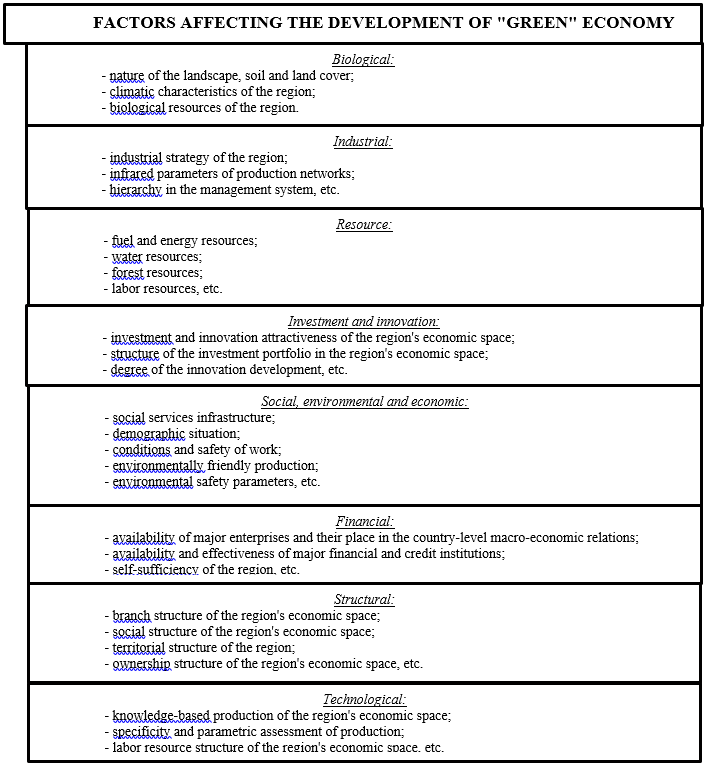
According to Mazunina (2012), to achieve a balanced, sustainable and qualitatively new "green" state of the region's economy is possible by a target strategic planning of the economic space focusing on: improvement of the quality of life and better public health, human capital growth; satisfaction of the material and spiritual needs of the population without causing unacceptable (according to sustainability criteria) environmental damage; compliance with and implementation of the rights of current and future generations; implementation of the development through a more efficient use of the intellectual potential.
The general trend of "green" economy on the way of sustainable development is aimed at total elimination of any form violence against man and nature. The main objective of the long-term regional development should be timely transformational changes to its economy caused by the global crisis phenomena by searching for a new niche of development taking into account the specifics of the region.
Any systemic change is a process, integrating a combination of financial and material resources. The effectiveness of their implementation depends on the time factor - systemic changes have to take place without any delays. A prerequisite for the development of "green" economy is the ability of the region, area or space to implement systemic changes in order to achieve a qualitative new level of sustainability. When forming a model of "green" economy we should take into account the following principles of planning sustainable development programs of the region's economic space: efficiency, minimizing risks, prioritizing, continuous development, adaptability, feasibility, targeting the needs of future generations, measurability, controllability, balance.
Analysis of the theoretical foundations and practical conditions for sustainable development in the region's development planning concept in conjunction with the study of the methodological precepts of sustainability and economic space development issues suggests that the methodology of sustainable development can be taken as an integrative basis for building an innovative model of the development of "green" economy.
The innovative model of the "green" economy development is understood as a set of interrelated elements and the mechanism of their interaction, aimed at preserving and enhancing the economic potential of the economic space. The concept of forming this model is based on the basic postulates of the concept of sustainable development. In general terms, the strategy to achieve the development towards "green" economy of the region can be represented as follows.
The model of the development of "green" economy should include a complex of activities that describe a set of integrated controls and management tools to impact the state of the economic space in the region, monitoring and controlling of the achievement of the set development goals.
Figure
Depending on the factors of the external environment impact, internal prerequisites for development, strategic objectives and individual characteristics, the development model of "green" economy of the region may include a plurality of different elements of financial, investment, managerial, marketing and other nature. A special role in the formation of the model is given to the human factor that is becoming more significant due to the actualization of the intellectual potential of the population.
One of the most important conditions for scientific planning is to simulate diverse situations and conditions of the regional economic space that allow for monitoring of future situations; varying factors influencing them; synthesizing the information obtained into the generalized patterns of development.
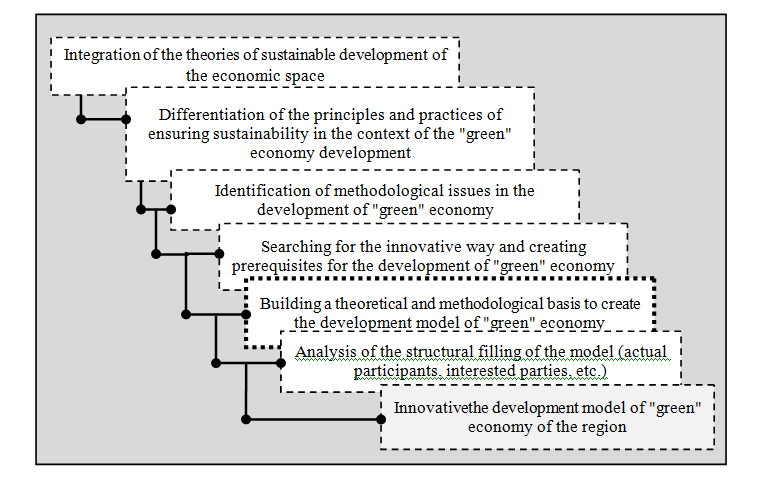
The logic of reasoning allowed the authors to identify the main typologically homogeneous types of the regional economic space by the relation of development sustainability - "green" economy (Fig. 3).

Development of the region occurs considering the specific characteristics of its economic space susceptibility to the effects of the external and internal factors combined, the influence of which can be described as a matrix of phase states of the "green" economy development (Fig. 4).
Determination of the phase state of the economic space is the theoretical basis for the development of regional programs for the development of "green" economy of the region, i.e. it can play the role of an abstract indicator of regional economic development prospects. A preferable phase in the development of "green" economy is a vector [+1; +1] (force +2), at which a relative resource saving occurs, associated with the intensive development on the way of "green" economy. Accordingly, a not preferable development is that of the regional economic space in the phase state with a vector [-1, -1] (force -2).
Simulation of situational development in view of the concept of "green economy" occurs in the area of poorly predictable effects attributed to the risks of internal and external environment and a number of restrictions, among which are: archaic and disordered structure of science, constraints of a financial nature, low productivity of the ongoing basic and applied research, etc.
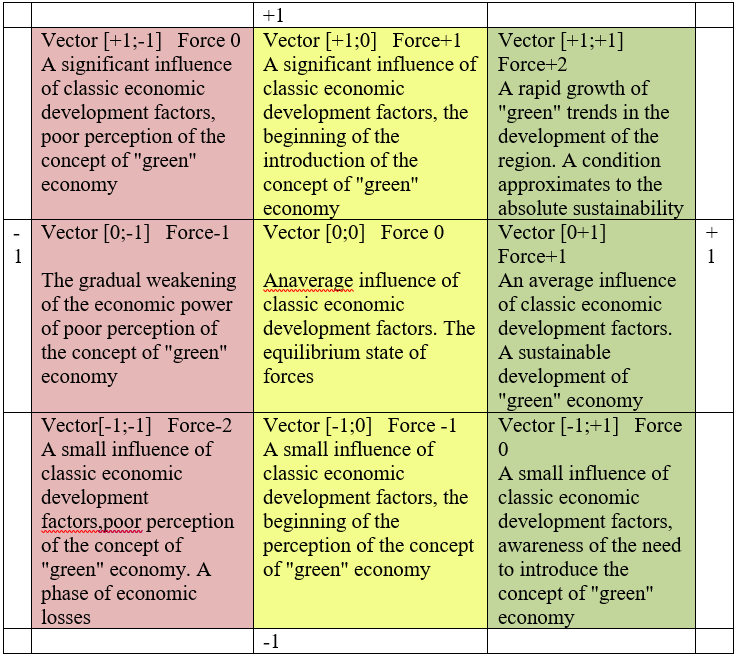
The current deep influence exerted by globalization trends on territorially cohesive spatial units characterized by a set of changes that generally can be classified as follows:
- emergence of the innovative aspect of the economic system is in direct collaboration with major international trends of the search for sustainable development;
- a widespread increase in the use of intangible assets of diverse nature;
- scaling of information flows and capitals at micro, regional, national and inter country levels.
The main objective in the formation of the "green" economy development model is the choice of optimal resource management in the region aimed at achieving the required level of target indicators.
The development of "green" economy is determined by the implementation of the region's total potential considering the factors affecting it. In order to form the development model of "green" economy of the region, let us use the inequality reflecting the basic conditions of "greening" the economy towards sustainable development:
dGER (H,N,F,I,In,Iv) / dt <= 1 (1)
where: GER (H, N, F, I, In, Iv) - the function of sustainable development of "green" economy of the region; H– human potential; N– natural potential; F– financial potential;I – institutional potential;In – innovation potential;Iv – investment potential (Bobylev, et al., 2007).
Evaluation of the ranked values of the resultant development index of "green" economy of the region represented in the model can be expressed as a gradation of threshold values defined by experts (Table
Figure
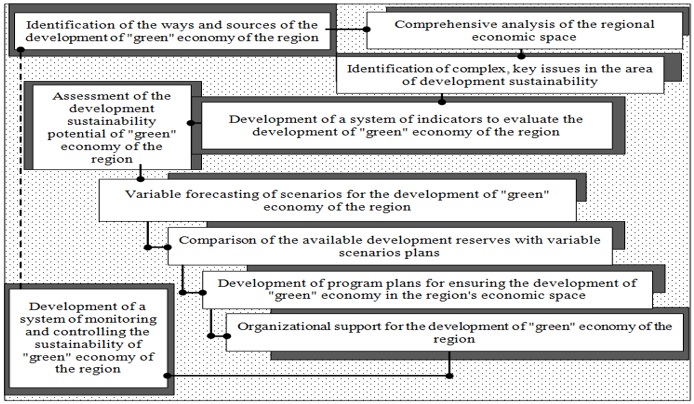
To conclude on the issues related to the simulation of the development of "green" economy of the region, let us look at the organizational support flowchart shown in Figure
The implementation algorithm to ensure the development of "green" economy of the region includes a complex of economic, organizational and legal procedures contained in all current and future plans for regional development.
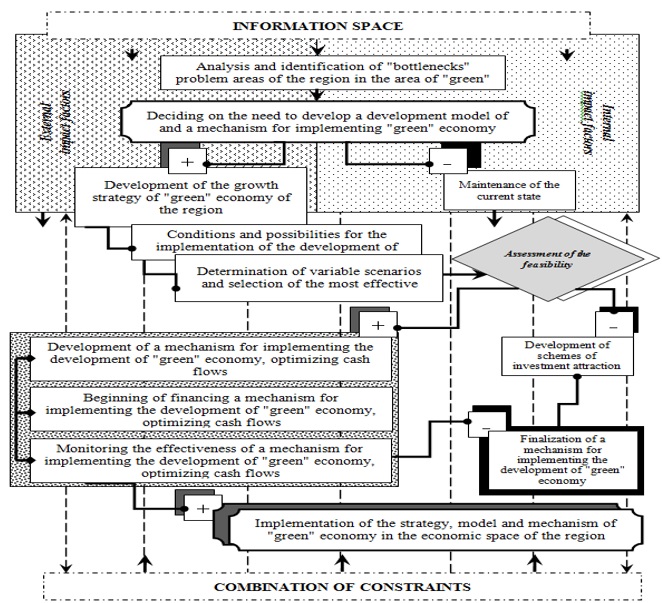
Improving the quality of managerial decisions at every stage of the implementation of the proposed algorithm is provided through a system of the feedback-based information support.
Stages of implementation of the monitoring and controlling system of the main indicators of the development of "green" economy of the region are presented in Table
Conclusion
A qualitatively new economic growth allowing overcoming the crisis in the regional development is due to the innovative aspects of a balanced, secure "green" growth. Further development of the regional economic space will be conditioned by the consolidation of reference points of growth, allowing focus on the eco-innovation towards sustainable development of "green" economy.
To ensure the development of "green" economy of the region, we must take into account the main factors affecting the sustainability of the economic state, the key features of a particular region, its susceptibility to changes of any nature. For this purpose, we can use economic and mathematical models of analysis and cause-effect relationships and the degree of innovation influence on the economic growth and sustainability similar to those described in (Kolmakov et al., 2015). Qualitative characteristics of the economic space are reflected in the regional programs, concepts of development, human potential. Comprehensive assessment of "green" economy will help to build the main trends of the modification rate of regional development.
In order to form an adapted program for the development of "green" economy within the economic space of each of the Russian regions, it is necessary to develop a methodology of evaluation parameters, use them as a basis for conducting a gradation of regions in terms of the development of "green" economy, and to develop recommendations for each group of regions on building a program for the development of "green" economy maximally adapted to their specificity.
Acknowledgements
The study was sponsored by the RFBR in the framework of the research project, number 16-36-00218, "The theory and methodology of assessing the development of "green" economy in the context of the theory of economic space"
References
- Bobylev, S. N., & Hodzhaev, А. Sh. (2007). Environmental. Lomonosov Moscow State University, economic faculty.
- Gaponenko, А. L. (2001). Strategy of social and economic development of a country, region, city. Publishing house RAGS.
- Kolmakov, V. V., Polyakova, A. G., &Shalaev, V. S. (2015). An analysis of the impact of venture capital investment on economic growth and innovation: Evidence from the USA and Russia. Economic Annals, 60(207), 7-37.
- Luneva, E.A. (2013). Ensuring sustainable balanced economic regional development based on the formation of the middle class ... candidate of Economics: 08.00.05. Murmansk State Technical University.
- Mazunina, М.V. (2012). The mechanism of sustainable socio-economic regional development ... candidate of Economics: 08.00.05. All-Russian Correspondence Financial and Economic Institute.
- Polyakova, A. G., & Simarova, I. S. (2014). The conceptual model of a region development administration considering the level of spatial relatedness. Economy of Region, (2), 32-42.
- Rudneva, L.N., Pchelintseva I. G., & Gureva, M.A. (2016). General Tendencies in Modern Economy: Sustainable Development and Green Economy. Journal of Environmental Management and Tourism Quarterly, VII (2), 14.
Copyright information

This work is licensed under a Creative Commons Attribution-NonCommercial-NoDerivatives 4.0 International License.
About this article
Publication Date
20 July 2017
Article Doi
eBook ISBN
978-1-80296-025-9
Publisher
Future Academy
Volume
26
Print ISBN (optional)
Edition Number
1st Edition
Pages
1-1055
Subjects
Business, public relations, innovation, competition
Cite this article as:
Rudneva, L., Pchelinceva, I., & Gureva, M. (2017). Creating a Development Model of "Green" Economy. In K. Anna Yurevna, A. Igor Borisovich, W. Martin de Jong, & M. Nikita Vladimirovich (Eds.), Responsible Research and Innovation, vol 26. European Proceedings of Social and Behavioural Sciences (pp. 286-294). Future Academy. https://doi.org/10.15405/epsbs.2017.07.02.37

